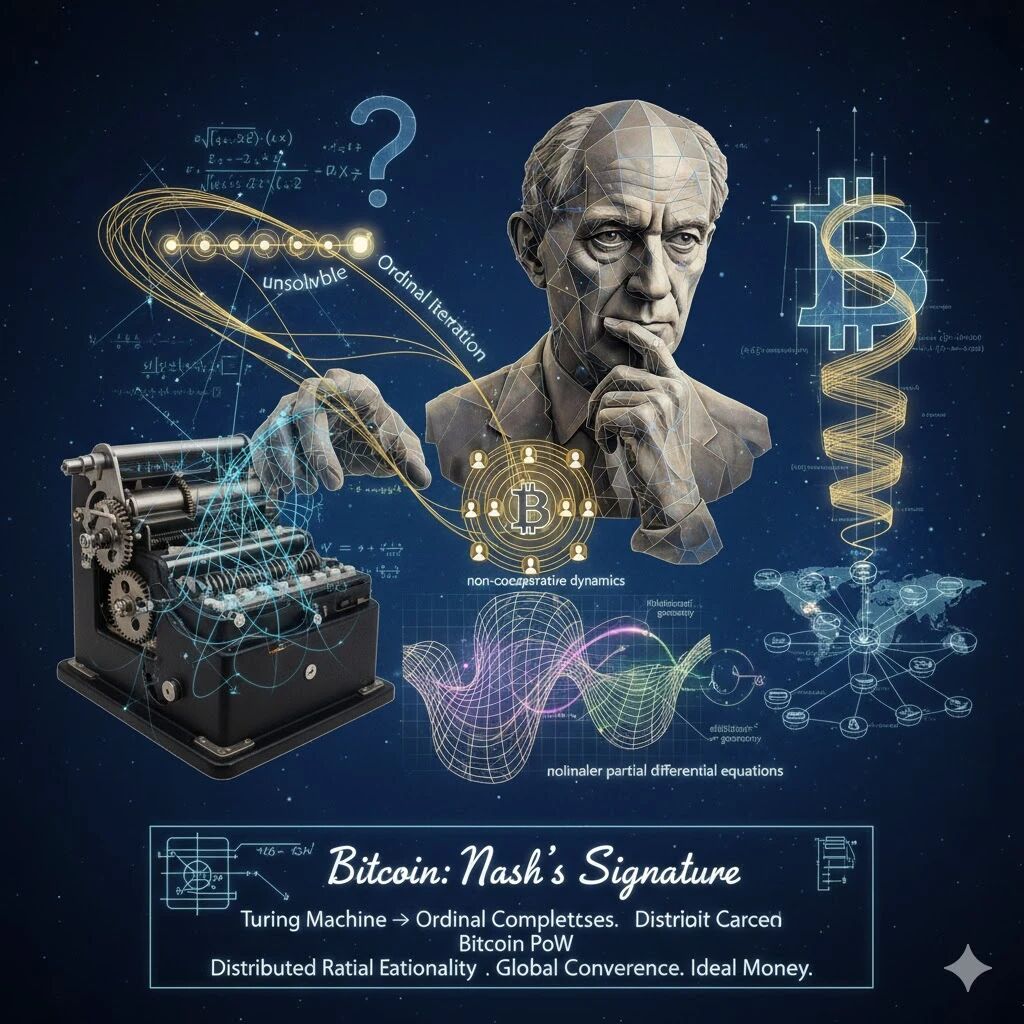
Turing’s Ordinal Logic System was an attempt to push the boundaries of formal system completeness built upon the theory of the Turing machine. By introducing the Oracle Machine and transfinite ordinal iteration, Turing sought to extend computation beyond the limits of what is computable.
However, the problem remained: such a system could not converge to a unique solution. The pursuit of formal completeness was, in logic, still left unresolved. Nash’s lifelong mathematical innovations focused precisely on this issue — he excelled at constructing higher-dimensional integrative structures between two formal systems, namely:
resolving the self-referential paradox of a single formal system through a nonlinear, embedded, non-cooperative logic.
1. Non-Cooperative Game Theory (Nash Equilibrium)
Nash expanded upon von Neumann’s “cooperative game formal system,” extending its boundaries of completeness. By introducing individual self-interest and non-cooperative dynamics, he enabled distributed systems to still converge toward equilibrium.
This idea represents the mathematical prototype of Bitcoin’s decentralized consensus built upon Turing’s ordinal logic system.
2. Nash Embedding Theorem
He achieved intrinsic fusion between two formal systems — Euclidean and Riemannian geometry — proving that any Riemannian manifold can be embedded within Euclidean space, thereby realizing the compatibility between different logical worlds.
This stands as the highest paradigm of “mappability between formal systems,” and it is precisely the ideal Turing’s ordinal logic aspired to achieve.
3. Nonlinear Partial Differential Equations and Elliptic Curve Analysis
Nash’s approach to nonlinear equations ushered mathematics from the linear world into an “adaptive completeness” within the nonlinear domain. This theoretical foundation later underpinned elliptic curve cryptography (ECC) — the very core of Bitcoin’s signature algorithm.
The structure of Bitcoin manifests Nash’s craft of formal system fusion through two recursive applications:
First recursion: Turing Machine System → Turing’s Ordinal Logic System
Turing’s computability resolved the verifiability of transactions, yet left an unfilled gap — the “double-spending problem.” This void was later bridged by Nash-style layered logical system extensions.
Second recursion: Ordinal Logic System → Nash’s Non-Cooperative Game System
Ordinal logic failed to converge to a unique solution. Through non-cooperative game logic, Nash enabled convergence under distributed self-interested behavior.
That is — Bitcoin’s Proof of Work (PoW) consensus mechanism achieves decentralized completeness right at the edge of incomputability.
Nash was not only a mathematician pursuing formal completeness but also a philosopher envisioning ideal money and a world citizen system.
To him, true money must possess:
Bitcoin is the engineered realization of this ideal.
Bitcoin is not merely the product of an algorithm, but a structural outcome of resolving the self-referential paradox of formal systems. It is neither purely a Turing-machine construct nor an extension of any single economic model — it is a Nash-style self-completing system:
achieving logical completeness within a non-cooperative world.
Nash, with a mathematician’s craftsmanship, resolved the formal paradox left by Turing and Gödel; with his vision of ideal money, he transformed that craft into engineering reality.
Thus —
Satoshi Nakamoto is not merely a name,
but the rebirth of Nash’s craftsmanship within the computational universe.